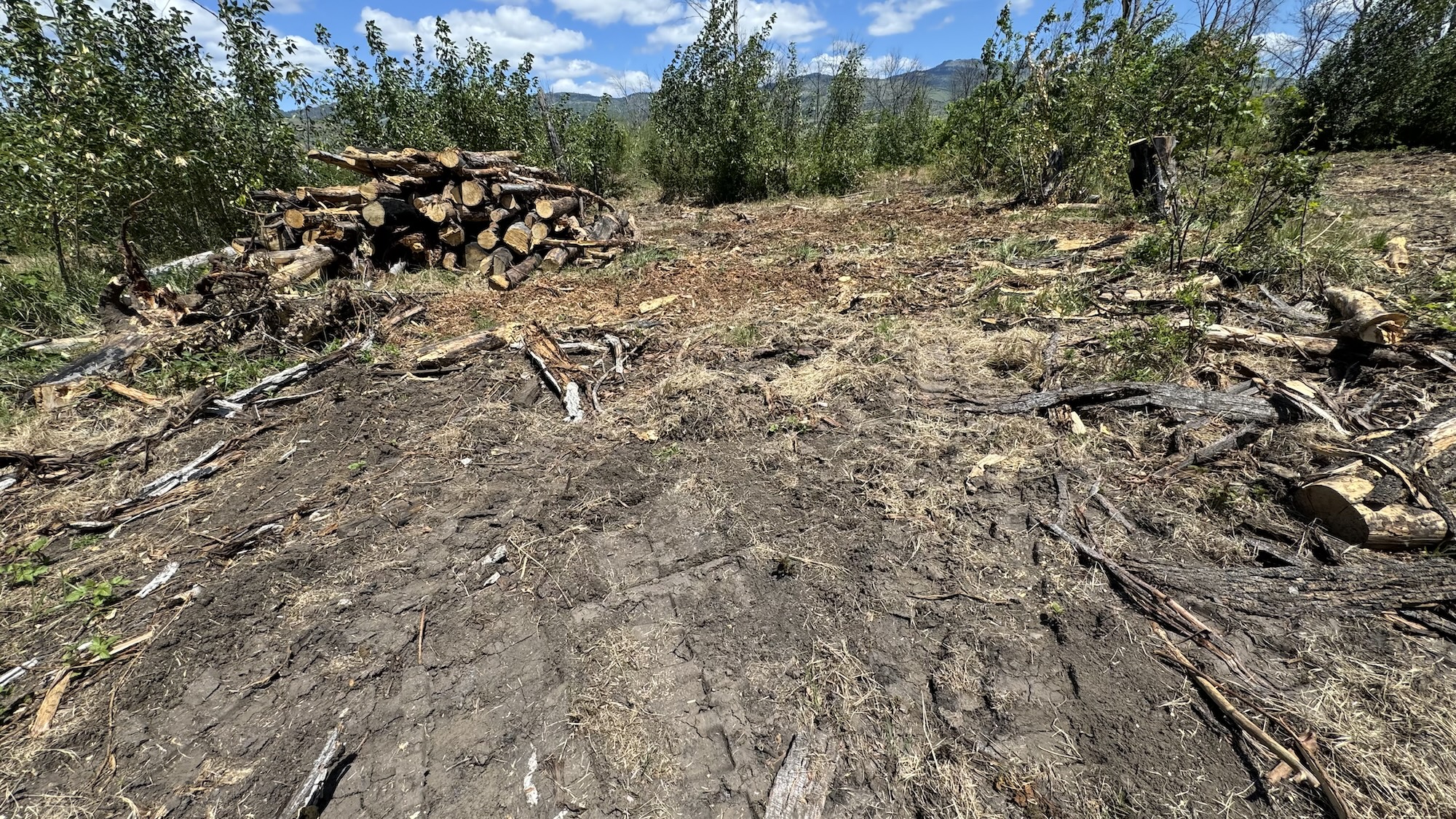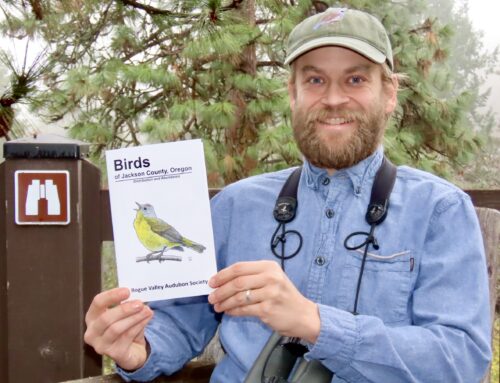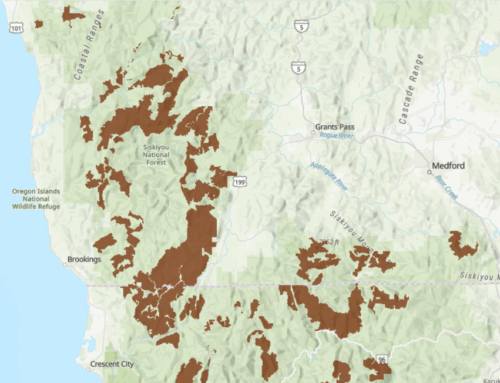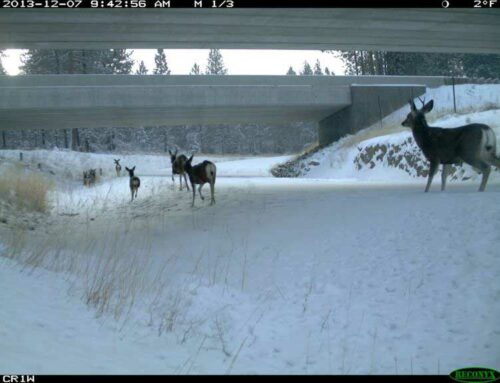The Conservation Column (to appear in the June issue of The Chat)
By Pepper Trail
For those of you involved in the Bear Creek Community Bird Survey – and for all of you who simply enjoy walking and birding along the Bear Creek Greenway – brace yourselves. Jackson County Parks has authorized the “Bear Creek Greenway Fuel Reduction’ project, and it is being carried out right now, at the height of songbird nesting season. This is no selective and “light touch” operation, but industrial in scale, with bulldozers and other heavy equipment creating massive amounts of ground disturbance, and removing most remaining snags.
There are five identified project areas, stretching from just north of Ashland all the way to Phoenix. Work is now essentially completed on the first section, which stretches north from the “Wrangler’s Gap” parking area to the Greenway Bridge over Bear Creek south of Lynn Newbry Park. I encourage you to visit and see for yourself the habitat disruption caused by this operation, with heavy equipment tracks everywhere, leading to piles of logged snags and crushed riparian shrubs surrounded by raw dirt scraped bare of all vegetation. I attach three photos I took in this “project area.”
According to Steve Lambert, director of Jackson County Parks, this work will continue until the officially-declared start of fire season; in other words, as long as they are legally allowed.
As RVAS members know, the riparian corridor of the Bear Creek Greenway is home to many ground and shrub-nesting songbirds, including Song Sparrows, Spotted and California Towhees, Yellow-breasted Chats, Bewick’s Wrens, Bushtits, and Lesser Goldfinches; and the snags are essential for cavity-nesting Northern Flickers, Acorn and Downy Woodpeckers, Tree Swallows, and Black-capped Chickadees, among others. All these birds and their nests are federally protected by the Migratory Bird Treaty Act. Unfortunately, there is a huge loophole that permits the “incidental take” associated with logging operations. Regardless, Jackson County Parks, as the custodian of the ecological integrity of this riparian corridor– a major reason for the Greenway’s creation – should certainly refrain from this kind of industrial-scale habitat disruption in the heart of the nesting season.
I have submitted a guest commentary to the Rogue Valley Times protesting this project – its scope and especially its timing. As of this writing, I don’t know if it will be published, so I include it here. I encourage all RVAS members concerned with this Bear Creek Fuels Reduction project to communicate their concerns to Jackson County Parks director Steve Lambert, at: LamberSM@jacksoncountyor.gov. In my opinion, the work should be stopped immediately, and resumed only after nesting (and fire) season. But even if that doesn’t happen, we need to strongly advocate that future management never again be scheduled during nesting season.
Where Have All the Greenway Songbirds Gone?
(Guest commentary submitted to the Rogue Valley Times, 5/20/24)
As a longtime birder, I am often asked this question by people I meet walking along the Bear Creek Greenway. I’ve usually answered by listing global threats behind the declines,
from habitat loss associated with climate change to collisions with windows to predation by feral cats. But right now, sadly, my answer must include “Their nests, eggs, and babies are being crushed beneath the bulldozers carrying out the ‘Bear Creek Greenway Fuel Reduction’ project.”
This work is being administered by Jackson County Parks and funded by the Oregon State Fire Marshal’s wildfire risk reduction grant program.
To see the destruction for yourself, take a walk along the Greenway between Ashland and Talent, on the section south of the Greenway bridge over Bear Creek. (You may need to go on the weekend, as this section is closed Monday-Friday while the work is being conducted.) You will see heavy equipment tracks everywhere, leading to piles of logged snags and crushed riparian shrubs surrounded by raw dirt scraped bare of all vegetation.
This vegetation once sheltered ground-nesting Song Sparrows and Spotted Towhees; the shrubs supported the nests of Yellow-breasted Chats, Bewick’s Wrens, Bushtits, and Lesser Goldfinches; and the snags were essential for cavity-nesting Northern Flickers, Acorn and Downy Woodpeckers, Tree Swallows, and Black-capped Chickadees, among others. And every other Greenway-nesting bird, from Yellow Warblers to Black-headed Grosbeaks to Bullock’s Orioles, is being subjected to the noise and disruption of this industrial logging operation – right in the height of nest-building and egg-laying season.
The management of the Bear Creek Greenway requires a challenging but essential balancing act among competing priorities, including public safety, fire hazard reduction, and the ecological integrity of this vital riparian corridor and its creek. This is especially true since the Almeda Fire, which killed many of the cottonwoods and other large trees along Bear Creek, creating an abundance of snags. In the months following the fire, many large snags near the Greenway bike path were removed for public safety. At the time, local environmental groups including the Rogue Valley Audubon Society advocated for the ecological value of the remaining snags, both as wildlife habitat when standing, and as woody structure for the creek and nutrient sources as they decay after falling.
Unfortunately, aggressive snag removal has continued, reportedly in response to public pressure on Jackson County Parks. Some of this pressure may simply reflect distaste for the “ugly” appearance of snags – an opinion that should have no influence on the management of the Greenway. More significantly, snag removal has been justified as fuels reduction. In fact, standing snags with few remaining side branches – the condition of the vast majority of snags along the Greenway – contribute very little to the spread of wildfire. The proven ecological value of snags far outweighs any hypothetical reduction in fire risk. Indeed, the extensive ground disturbance associated with this industrial logging operation could well INCREASE fire risk by promoting the growth of blackberries and other highly flammable invasive plants.
But even if we were to accept that yet another round of snag removal is justified, there is NO justification for carrying out this work now, at the height of nesting season. And there is no justification for the industrial scale of this operation – any work should be carried out with a light touch, with experienced crews working with chainsaws and hand-piling cleared vegetation. Yes, we understand that the county contracting process is complex and leads to delays. Yes, we understand that it can be difficult to find contractors willing and able to carry out the project with a light touch. But if the work cannot be done in an ecologically responsible manner, and at a time of year that does not result in the destruction of countless nests of protected bird species, it should not be done at all – and should be stopped right now in its bulldozer tracks.







Leave A Comment
You must be logged in to post a comment.